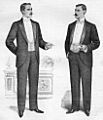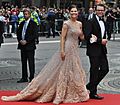Tuxedo facts for kids
A tuxedo is a special outfit worn for formal events. It usually includes a white dress shirt, a bow tie, dress pants, a tuxedo jacket (also called a dinner jacket), and shiny leather shoes. Sometimes, people also wear a vest or a cummerbund (a pleated sash around the waist), a top hat, and gloves with it.
In many European countries, this outfit is called black tie. Men in Western countries often wear a tuxedo for important occasions. These can include a wedding, a fancy party, or a special dance.
The white dress shirt is often made from cotton or linen. It has a stiff collar and is ironed to look neat. A bow tie is usually black or white and made of silk or polyester. The dress pants are made of wool or polyester and are also ironed.
The tuxedo jacket is usually made of wool or polyester. It has a collar, pockets, and a smooth lining. The leather dress shoes are usually dark and polished. Some people add a sleeveless vest with buttons, a black top hat, and white gloves to their tuxedo.
Some men wear a tuxedo for their jobs. This includes musicians in a symphony orchestra or waiters in very fancy restaurants.
Most men do not wear tuxedos often. Because of this, they usually rent them instead of buying them. Sometimes, the vest and tie of a man's tuxedo will match the dress of the woman he is with. Tuxedos are mainly worn to big events like weddings or formal dinner parties.
Contents
What's in a Tuxedo?
A tuxedo is a complete outfit. It includes several key pieces of clothing.
The Jacket
The tuxedo jacket is often black or dark blue. It can have different types of collars. These jackets are usually made from fine wool or polyester. They often have shiny silk on the lapels (the folded parts of the collar).
The Shirt and Tie
The shirt is a special white dress shirt. It has a stiff collar and sometimes special pleats on the front. A bow tie is worn around the neck. It is usually black, but can be other colors.
The Pants and Shoes
Tuxedo pants are usually black and match the jacket. They often have a single stripe of silk down the side of each leg. The shoes are usually black leather dress shoes. They are often very shiny, sometimes made of patent leather.
Other Accessories
- A cummerbund is a pleated sash worn around the waist. It covers the waistband of the pants.
- A vest can be worn instead of a cummerbund. It is a sleeveless garment with buttons.
- Cufflinks are used to fasten the cuffs of the shirt.
- A pocket square is a small piece of fabric placed in the jacket's breast pocket.
Where Did the Name "Tuxedo" Come From?
The word tuxedo for this type of suit started in the United States. It began around the year 1888. The suit was named after a place called Tuxedo Park, New York. This was a special area in New York where many wealthy people lived. They often wore this new style of suit.
At first, the word "Tuxedo" was capitalized. It only referred to a white jacket. Later, in the 1900s, the jacket was worn with matching pants and other items. Then, the name "tuxedo" started to mean the whole suit. Sometimes, people shorten the name to "tux".
In many European languages, like French, Spanish, and German, this suit is called smoking. This word sounds like "smoking" in English. It comes from the old "smoking jacket" of the 1800s. In French, it can also be called "cravate noire," which means "black tie."
Sometimes, people jokingly call a tuxedo a monkey suit. Since 1918, it has also been called soup and fish. This name comes from the types of food often served at formal dinners where tuxedos are worn.
Related pages
Images for kids
-
Victoria, Crown Princess of Sweden and Prince Daniel, Duke of Västergötland arriving at a Black Tie Gala.
-
Jacob Rees-Mogg in black tie at a debate.
-
Elizabeth II, Prince Philip, Duke of Edinburgh, President John F. Kennedy, and Jacqueline Kennedy Onassis at Buckingham Palace (1961).
-
President Ronald Reagan, Audrey Hepburn, and Robert Wolders at a private dinner (1981).
-
Michael Mullen congratulating Tony Blair at a gala (2008).
-
Actors Angelina Jolie and Brad Pitt at the Academy Awards (2009).
-
King Carl XVI Gustaf and Queen Silvia of Sweden at Stockholm City Hall (2011).
See also
 In Spanish: Esmoquin para niños
In Spanish: Esmoquin para niños






















